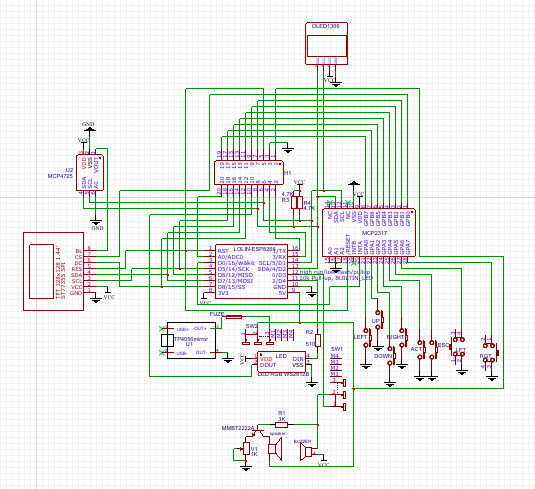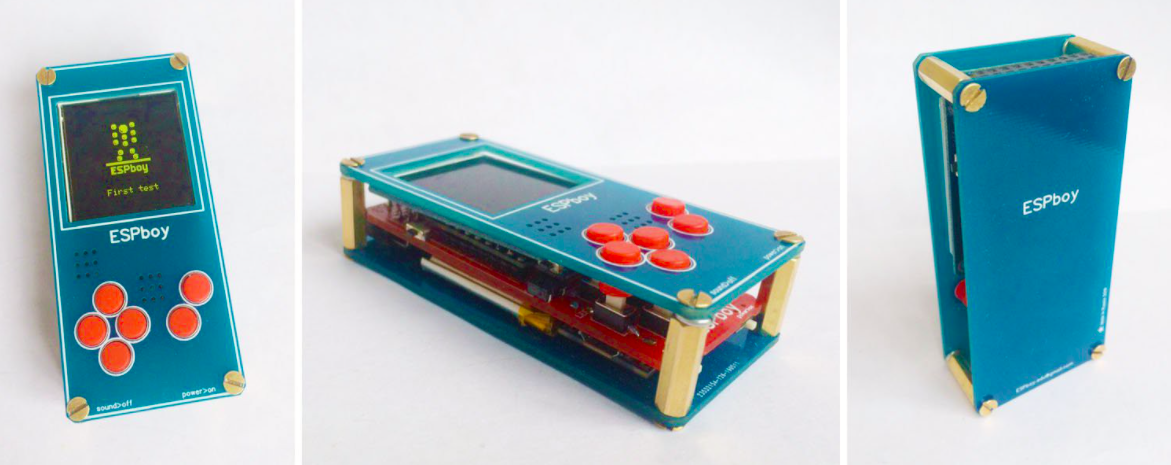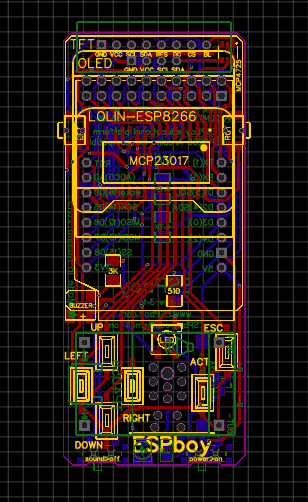I made an ESPboy gadget based on the well-known microcontroller ESP8266 80 / 160Mhz, 4 / 8Mb with a 128x128 TFT color screen, sound, RGB LED, battery with charging and WiFi on board.
It turned out an autonomous, modular platform that can be soldered in a couple of hours from parts, costing about $ 12 and carried in your pocket.
Assembly instructionsThe
baseboard is drawn at
easyeda.com , manufactured by
jlcpcb.com .
All components are standard, easily available for pennies on
aliexpress.com .
It can be used as a platform for learning and rapid prototyping, as a retro game console, as a platform for developing toys and entertainment with IoT.
There is a connector on which all interfaces are displayed (SPI, I2C, UART, etc.), where you can connect native modules and your own extensions.
It is programmed by ESPboy in the usual way through the Arduino IDE, as the ESP8266 is almost completely compatible with the Arduino ecosystem and libraries. For advanced, there are
native SDKs from Espressif Systems NONOS or RTOS . Various additional environments for programming and building firmware are also available, such as LUA,
Micropython ,
scratch ,
wifi-iot.com ,
fl-prog ,
Visuino and thousands of others.
On board the ESP8266 there is built-in WiFi, which adds network capabilities for communications between devices and for exporting data to the network, and much more. For example, you can easily communicate with online services such as
RemoteXY ,
Blynk ,
Thingspeak ,
HiveMQ ,
CloudMQTT ,
NarodMon ,
MajorDoMo ,
ThingerIO ,
Google cloud IoT ,
dweet.io ,
Temboo ,
Xively ,
IFTTT ,
LORA-WAN .
Technical details and assembly instructions can be viewed on hackaday
The project grew out of a love of homemade products and retro devices, fussing with
Arduino and getting to know such things as:
Arduboy ,
Gamebuino ,
Pokitto ,
m5stack .

Surprisingly, all such devices except m5stack are exclusively focused on games, which nowadays is already becoming quite a tangible evil for children, very skillfully modern game maiden sharks got used to plant fragile minds on them.
For engineering surveys, there are classic
Arduins , but these boards look soulless and require a rather painstaking long understanding for a novice to assemble and program some complete functional device from scratch.
I came up with the idea of educational benefits and training for children and interested adults through reverse engineering.
That is, to learn in the opposite direction, not from the faceless boards and wiring to the finished device, the devil knows when, but from a fully working gadget, through curiosity: "how it works and works." Something similar is felt in the
m5stack.com project, but in my opinion it is too solid and closed.
Having assembled an ESPboy device on your own, you can immediately learn something and get the effect of an engineering enthusiast’s enthusiasm because a full-fledged retro console with cool toys pre-sewn into the microcontroller suddenly comes to life from faceless glands in its hands.
The effect is similar to the feeling after self-assembly of the IKEA cabinet.

It makes it easier that the Chinese with pcbway.com, in addition to manufacturing the main board, can neatly solder all the small parts, after which it remains to solder only the speaker, battery charging module, microcontroller board, display and attach the battery with your own hands.
As experiments have shown, people who are far from DIY, radio electronics and a soldering iron in their hands have never held it in their hands in less than an hour.

Further, there is scope for learning gamedev or IoT.
Game development is a separate matter; you can use
Igor’s LGE engine, for example.
And in the development of IoT will help native modules that are easily inserted into an existing connector and open sketches for them. Having played enough and experimented with ready-made additions, instructions and source codes and thus obtained basic knowledge, you can already invent and craft your own from scratch.
It’s supposed to interrogate either the
ESP little game engine with built-in games from Igor, who kindly ported his development to ESPboy or
the CHIP8 / SCHIP emulator of games with about 90pcs of built-in games , which I managed to write not so long ago.
Ready-made modules are already available, by inserting them into the ESPboy expansion slot and filling in the firmware, you can get a fully-functional gadget of your choice: weather station, mp3 player, fm receiver, navigator, keyboard, GSM phone. The code is naturally available on GitHub.
It is planned to make some more cool modules: LORA messenger (which works without any communication whatsoever for 8km), an environmental monitor (with a dosimeter, phenol sensor, CO2, etc.), a barcode scanner, a thermal imaging camera, wifi radio and several others .
Also in the process of writing a simple browser and twitter client, creating an online directory with firmware so that you can download software by connecting to the online directory via WiFi. Without wires, fuss with IDE settings, compilations (by the type, as today, the search and installation of software on smartphones with Google play or the Apple store).
The further process of comprehending all this DIY microcontroller-programmer magic can go through the Internet and youtube in the classical way, since there is plenty of educational material today. In case of difficulty, the
ESPboy community forum
will prompt.
Time will tell how viable the idea and concept is, but so far testing and feedback are encouraging!
All good and success in creativity.
Respectfully,
Roman S.